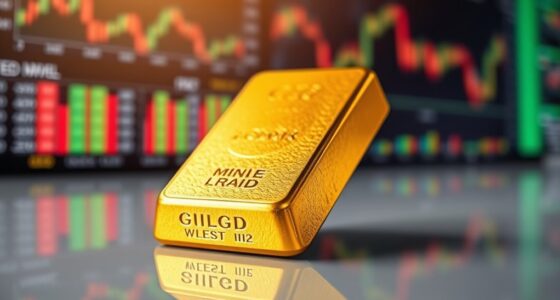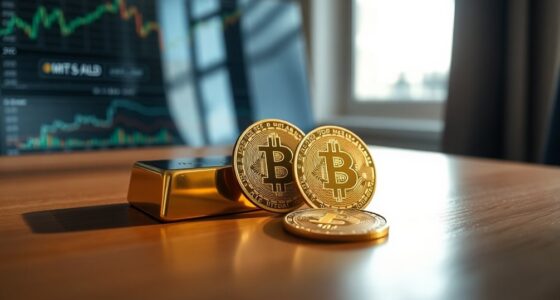Rising interest rates don’t necessarily crush gold, especially when you consider historical trends. While higher rates often make bonds and cash more attractive, gold tends to perform well during periods of falling or negative real yields, which happen when inflation rises faster than nominal rates. In times of economic uncertainty or high inflation, gold can even rally amid rate hikes. If you’re curious about how these dynamics have played out over time, you’ll find plenty of insights if you keep exploring.
Key Takeaways
- Historical data shows gold often rises during periods of rising nominal rates if real yields remain negative or low.
- Gold’s inverse relationship with real interest rates remains strong, meaning rising rates don’t always suppress gold prices.
- During inflationary periods, even with increasing interest rates, negative real yields can drive gold higher.
- Gold acts as a safe haven during economic stress, which can outweigh the impact of rising interest rates.
- Long-term trends indicate falling or negative real yields are more influential on gold’s upward movement than nominal rate increases.

As interest rates rise, many investors wonder how gold will respond. Historically, the relationship between gold prices and real interest rates is strongly negative. When real yields increase, gold often declines, and when real rates fall or turn negative, gold tends to rise. Data from 1973 to 2013 shows that the biggest gold booms happened during periods of negative real interest rates, especially in the late 1970s and late 2000s. While the inverse relationship isn’t guaranteed every cycle, it remains a dominant long-term trend. Large rallies, like those from 2008 to 2012 and 2019 to 2021, coincided with falling real yields amid global easing policies. According to Erb and Harvey (2021), the correlation between real interest rates and gold is about -0.82, indicating a strong inverse relationship.
Understanding why real rates matter helps clarify this connection. Real interest rates represent the opportunity cost of holding gold, which doesn’t offer interest or dividends. When real yields are positive, cash and bonds become more attractive investments, reducing the demand for gold. Conversely, when real yields are negative or very low, gold’s appeal increases because holders of cash or bonds lose purchasing power. Rising nominal rates alone don’t always hurt gold; in fact, gold fell in the 1980s when real yields turned positive, even if nominal rates were rising. Gold can still rally during periods of high nominal rates if inflation outpaces those rates, turning real yields negative.
Gold is also regarded as a safe haven during economic uncertainty, regardless of rate movements. Even with rising interest rates, demand for gold can spike if inflation or geopolitical risks intensify. Gold’s lack of yield makes it less attractive during strong, high-yield environments but more appealing during times of instability or deflation. During economic slowdowns or crises, gold often outperforms other assets, and its safe-haven status can sometimes decouple its price from the inverse rate relationship during extreme stress.
Furthermore, gold’s response correlates more closely with inflation-adjusted (real) interest rates than with nominal rates alone. When inflation exceeds nominal rates, real yields turn negative, boosting gold demand. This explains why gold often rallies amid high inflation, even if nominal rates increase, because real returns on cash and bonds worsen. In the 1970s, high inflation and high nominal rates still led to gold surges because real yields were deeply negative. Similarly, declines in real yields in the 2000s and 2010s fueled major gold rallies. Additionally, central bank policies can influence these dynamics, as rate hikes or cuts impact inflation expectations and real yields.
In the short term, gold prices can be volatile and may not always follow the inverse relationship with real rates. However, over the long run, the trend remains clear: falling or negative real yields tend to support higher gold prices, while rising real yields often suppress them. This dynamic underpins gold’s behavior, regardless of short-term rate fluctuations.
Frequently Asked Questions
How Do Geopolitical Events Influence Gold Prices During Rising Interest Rates?
When geopolitical events occur during rising interest rates, you might expect gold to decline, but history shows otherwise. During crises, you tend to see gold prices spike as investors seek safety, regardless of rate increases. These events create uncertainty that outweighs the impact of higher rates. So, even with rising interest rates, geopolitical turmoil can boost gold demand, making it a resilient safe haven that often defies rate hikes.
What Role Does Currency Fluctuation Play in Gold Investment During Rate Hikes?
You should understand that currency fluctuations considerably influence gold investments during rate hikes. When the dollar weakens, gold becomes cheaper for international buyers, boosting demand and prices. Conversely, a stronger dollar can suppress gold’s appeal. However, uncertainties and inflation concerns often drive investors toward gold as a hedge, especially if currencies are unstable. So, even amid rising interest rates, currency movements can sustain or increase gold’s attractiveness as a safe haven.
Can Central Bank Policies Override Historical Trends in Gold and Interest Rates?
Central bank policies can definitely override historical trends in gold and interest rates. When policies focus on inflation targeting or economic stability, they influence investor sentiment and inflation expectations, which often boost gold demand even during rate hikes. You should watch how central banks communicate and act, because their policies can shift the usual relationship between interest rates and gold, making gold more resilient despite rising rates.
How Does Inflation Impact Gold’s Performance Amid Rising Interest Rates?
You might think rising interest rates will push gold prices down, but inflation plays a bigger role. When inflation rises, gold often gains because it’s a hedge against currency devaluation, even if rates are climbing. During uncertain times, demand for gold increases as a safe haven. So, despite higher rates, inflation’s influence and economic uncertainty can maintain or boost gold’s value, proving its resilience over time.
What Are the Long-Term Effects of Rising Interest Rates on Gold Demand?
Imagine a tug-of-war where rising interest rates pull gold demand in one direction, but economic uncertainties and inflation fears push back. Over the long term, historical data shows gold often withstands these pressures, especially when real interest rates stay negative. You’ll see that despite rate hikes, gold can still shine, driven by investor sentiment, geopolitical events, and market dynamics that keep its appeal alive even amidst rising rates.
Conclusion
So, as you watch interest rates climb, remember that gold’s history suggests it often shines brighter in uncertain times. It’s almost a coincidence—just when you think rising rates will crush gold, it proves resilient, offering you a safe haven. Trust in these patterns, and don’t let fleeting fears blind you. Sometimes, the most unexpected events remind us that gold’s value isn’t just about economics, but about the hope and stability it can still bring to your future.





